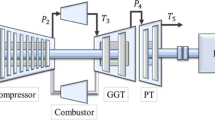Abstract
An adaptive model is proposed based on genetic algorithm to predict the characteristic map of aeroengine components. The difference functions, of the primary performance parameters between numerical model and test data, are taken as objective function. The coupled factors of component characteristics’ map as optimized parameters are considered.The difference of the main performance parameters and process parameters between the adaptive model and the test data are shown to be within the range of 0.05%.Meanwhile, the section’s total temperature and pressure are controlled within 1%. Furthermore, an aerongine fault diagnosis model is developed by the small deviation equation method in which the gas path analysis is implemented and the symptom and measuring parameters represent engine performance parameters’ variation. It shows that the selection and relatively variable value of symptom parameter have great effect on fault diagnosis error, and the best selection of value is 1/3 of threshold. The relative error of variable value between the symptom parameter of fault diagnosis model and the real fault can be found to be controlled within 5% and it can do the correct evaluation of fault type. And the fault diagnosis model has no misdiagnosis in all the performed conditions.
Similar content being viewed by others
References
Stamatis, A., Mathioudakis, K., and Berios,. “Jet Engine Fault-Detection with Discrete Operating Points Gas Path-Analysis,” Journal of Propulsion and Power, Vol. 7, No. 6, pp. 1043–1048, 1991.
Zedda, M. and Singh, R., “Gas Turbine Engine and Sensor Fault Diagnosis using Optimization Techniques,” Journal of Propulsion and Power, Vol. 18 No. 5, pp. 1019–1025, 2002.
Ogaji, S., Sampath, S., and Marinai, L., “Evolution Strategy for Gas- Turbine Fault-Diagnoses,” Applied Energy, Vol. 81, No.2, pp. 222–230, 2005.
Simon, D. and Simon, D. L., “Analytic Confusion Matrix Bounds for Fault Detection and Isolation Using a Sum-of-Squared-Residuals Approach,” IEEE Transactions on Reliability, Vol. 59, No. 2, pp. 287–296, 2010.
Dewallef, P. and Borguet, S. “A Methodology to Improve the Robustness of Gas Turbine Engine Performance Monitoring Against Sensor Faults,” Journal of Engineering for Gas Turbines and Power-Transactions of the ASME, Vol. 135 No. 5, 051601, 2013.
Donat, W., Choi, K., and An, W., “Data Visualization, Data Reduction and Classifier Fusion for Intelligent Fault Diagnosis in Gas Turbine Engines,” Journal of Engineering for Gas Turbines and Power-Transactions of the ASME, Vol. 130 No. 4, 041602, 2008.
Urban, L. A., “Parameter Selection for Multiple Fault Diagnostics of Gas turbine Engines,” Journal of Engineering for Power, pp. 225–230, April 1975.
Urban, L. A., “Gas Path Analysis Applied to Turbine Engine Condition Monitoring,” AIAA-1972-1082, 1972.
Stamatis, A., Mathioudakis, K., and Papailiou, K. D., “Adaptive Simulation of Gas Turbine Performance,” Vol. 112, pp. 168–175, April 1990.
Singhr, “The Role of Gas Path Diagnostics in the Changing Gas Turbine After-Market,” Journal of Aerospace Sciences and Technologies, Vol. 57, No. 1, pp. 58–72, 2005.
Swan, J. A. and Vizzini, R, W., “Analytical Redundancy Design for Improved Engine Control Reliability Finial Review,” AIAA-88-3176.
Luppold, R. H., Gallops, G. W., and Kerr, L. J., et al., “Estimating In-Flight Engine Performance Variations using Kalman Filter Concepts,” AIAA-89-2584.
Stamatis A., Mathioudakis K., and Papailiou K. D., “Adaptive Simulation of Gas Turbine Performance,” Journal of Engineering for Gas Turbine and Power, Vol. 112, No. 4, pp. 168–175, 1990.
Aretakis, N., Mathioudakis, K., and Stamatis, A., “Identification of Sensor Faults on Turbofan Engines using Pattern Recognition Techniques,” Control Engineering Practice, 2003.
Deb, K., “Computationally Efficient Evolutionary Algorithm for Real Parameter Evolution,” Evolutionary Computation Jounal, Vol. 10, No. 4, pp. 371–395, 2002.
Wang. Y. J., Zhang, J. S., and Zhang, G. Y., “A Dynamic Clustering based Differential Evolution Algorithm for Global Optimization,” European Journal of Operational Researeh, Vol. 183, pp. 56–73, 2007.
Chootinan, P. and Chen, A., “Constraint Handling in Genetic Algorithms Using a Gradient-based Repair Method,” Computers & Operations Researeh, Vol. 33, pp. 2263–2281, 2006.
Venkatraman, S. and Yen, G. G., “A Genetie Frame Work for Constrained Optimization Using Genetic Algorithms,” IEEE Transactions on Evolution Computation, Vol. 9, No. 4, pp. 424–435, 2005.
Kumar, K., Dubey, A. K., and Pandey, A. K., “Computer-Aided Genetic Algorithm based Multi-Objective Optimization of Laser Trepan Drilling,” Int. J. Precis. Eng. Manuf., Vol. 14, No. 7, pp. 1119–1125, 2013.
Lin, C. W., “Simultaneous Optimal Design of Parameters and Tolerance of Bearing Locations for High-Speed Machine Tools using a Genetic Algorithm and Monte Carlo Simulation Method,” Int. J. Precis. Eng. Manuf., Vol. 13 No. 11, pp. 1983–19885, 2012.
Prabhaharan, G., Asokan, P., Ramesh, P., and Rajendran, R., “Genetic-Algorithm-based Optimal Tolerance Allocation using a Least-Cost Model. November”, Int. J. Precis. Eng. Manuf., Vol. 24 No. 9–10, pp. 647–660, 2004.
Author information
Authors and Affiliations
Corresponding author
Rights and permissions
About this article
Cite this article
Xiao, H., Xu, ZZ., Kim, LS. et al. Optimization scheme of genetic algorithm and its application on aeroengine fault diagnosis. Int. J. Precis. Eng. Manuf. 16, 735–741 (2015). https://doi.org/10.1007/s12541-015-0097-y
Received:
Revised:
Accepted:
Published:
Issue Date:
DOI: https://doi.org/10.1007/s12541-015-0097-y




